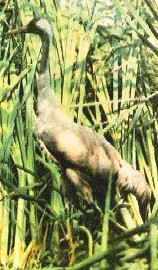 Synonyms:
None
Synonyms:
NoneGrus grus Linnaeus, 1758
 Synonyms:
None
Synonyms:
None
Common names: Bulg: Syv zhurav; Rom: Cocor mare; Engl: Crane; Russ: Sery zhuravl'; Turk: Turna; Ukr: Siry zhuravel'
Order: GRUIFORMES
Family: GRUIDAE
Taxonomic descriptions: The species is also included in Appendix I of Birds Directive 79/409/EEC, Appendix II of the Bonn Convention and Appendix II of the Bern Convention. At present the nesting of Common Crane in the Black Sea Region is Danube Delta (Radu, 1979) and in the Northern Sivash (Siokhin,1982). In all the other parts of the Black Sea region the species is migratory, summer visiting and wintering.
 IUCN Status:
IUCN Status:
World level: LR
Black Sea Regional level: LR
Subregion level: VU in Ukraine
Distribution: The main direction of spring migrations are north-eastern, northern, eastern. In autumn the first young birds arrive in the northern part of Black Sea region at the end of August. The mass passage begins in late September and continues up to mid-October. The last ten days of October and mid-November are the period for separate birds or small flocks of several individuals to appear. The migration routes can be distinguished over the territory of Black Sea region. In the north-western part the main direction is south-western and southern, in the Crimea - is southern and south-western, in the valley of the Dnieper leads along the coastline of the Black Sea.
The biggest gathering site in the Black Sea region situated in the zone between the biosphere reserve Askania-Nova and Sivash where more than 40,000 Common Crane gather. During the autumn migration more than 50,000 cranes flew in 1996 through Askania-Nova. The second large gathering and resting area is situated in North Sivash (Djankoy region) with 10,000 cranes every autumn. Many small places of crane assemblages are scattered over the region. In the winter some groups of Common Crane stay till mid-December and a few birds stay in winter. Nearly 100,000 cranes fly through Black Sea region every autumn. 20,000 - 30,000 cranes fly along the western Black Sea coast through Romania and Bulgaria; 50,000 - 60,000 fly through Crimea Peninsula and 10,000 probably fly along Caucasis coast.
Habitats type, Critical habitats, Limiting factors: Valleys of large rivers and swamps, relatively shallow lakes covered by reeds. Premigratory gathering of cranes are situated on the salinated bays of Sivash, sand-bars. The cranes feed in the winter and spring crops, harvested cornfields, pastures.
Biology: The arrival time is between February 20th and March 5th with two peaks. A first peak was observed in mid-March and the second peak in the first half of April.
Population trends: The number of the birds in the region is stable.
Threats: Habitat transformation, human disturbance, hunting, poisoning in the fields.
Conservation measures taken: At present the main gathering places are not protected.
Conservation measures proposed: Expansion of the area of the Azov-Sivash National Park and some places in Northern Sivash to be included in it.
References:
Compiled by: P.Gorlov